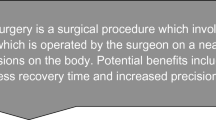Abstract
Introduction
Because of the complex nature of laparoscopic suturing, numerous curricula have been developed to overcome the steep learning curve in a patient-free environment. Distributed training leads to better acquisition and retention of skill compared with massed training. However, this requires considerable time commitment of experts that supervise these training sessions. This study investigates the possibility of replacing expert supervision by structured training with video demonstrations and peer feedback.
Materials and methods
The study population consisted of two balanced groups of ten senior medical students with minimal experience in laparoscopy. The control group trained with continuous expert feedback while for the experimental group only video demonstrations and external feedback from peers were available. Training was completed when a previously determined expert level was achieved on two consecutive attempts (proficiency criterion). Students were tested on their suturing skills 1 week after the training as well as after 4 months. A composite score assessing quality and quantity of suturing performance was used. Data are shown as median (interquartile range, IQR).
Results
Students’ performance improved more than 200% after training. Learning curves did not differ between groups (p = 0.28). One week after training, scores were 192 s (IQR 65 s) for the control and 190 s (IQR 27 s) for the experimental group (p = 0.63). After 4 months this was 223 s (IQR 88 s) and 220 s (IQR 37 s), respectively (p = 0.60).
Conclusions
Both training methods are very efficient at improving laparoscopic suturing skills and provide excellent skill retention. We therefore conclude that structured training with video demonstrations and peer feedback can replace expert supervision to teach laparoscopic suturing skills to novices. This will facilitate practical organization of skills training.





Similar content being viewed by others
References
Wanzel KR, Ward M, Reznick RK (2002) Teaching the surgical craft: From selection to certification. Curr Probl Surg 39(6):573–659
Moulton CA, Dubrowski A, Macrae H, Graham B, Grober E, Reznick R (2006) Teaching surgical skills: what kind of practice makes perfect?: a randomized, controlled trial. Ann Surg 244(3):400–409
Pearson AM, Gallagher AG, Rosser JC, Satava RM (2002) Evaluation of structured and quantitative training methods for teaching intracorporeal knot tying. Surg Endosc 16(1):130–137
Stefanidis D, Korndorffer JR Jr, Sierra R, Touchard C, Dunne JB, Scott DJ (2005) Skill retention following proficiency-based laparoscopic simulator training. Surgery 138(2):165–170
Korndorffer JR Jr, Dunne JB, Sierra R, Stefanidis D, Touchard CL, Scott DJ (2005) Simulator training for laparoscopic suturing using performance goals translates to the operating room. J Am Coll Surg 201(1):23–29
Stefanidis D, Korndorffer JR Jr, Markley S, Sierra R, Scott DJ (2006) Proficiency maintenance: impact of ongoing simulator training on laparoscopic skill retention. J Am Coll Surg 202(4):599–603
Rogers DA, Regehr G, Gelula M, Yeh KA, Howdieshell TR, Webb W (2000) Peer teaching and computer-assisted learning: An effective combination for surgical skill training? J Surg Res 92(1):53–55
Rogers DA, Regehr G, Howdieshell TR, Yeh KA, Palm E (2000) The impact of external feedback on computer-assisted learning for surgical technical skill training. Am J Surg 179(4):341–343
Stefanidis D, Korndorffer JR Jr, Heniford BT, Scott DJ (2007) Limited feedback and video tutorials optimize learning and resource utilization during laparoscopic simulator training. Surgery 142(2):202–206
Xeroulis GJ, Park J, Moulton CA, Reznick RK, Leblanc V, Dubrowski A (2007) Teaching suturing and knot-tying skills to medical students: a randomized controlled study comparing computer-based video instruction and (concurrent and summary) expert feedback. Surgery 141(4):442–449
Jowett N, LeBlanc V, Xeroulis G, MacRae H, Dubrowski A (2007) Surgical skill acquisition with self-directed practice using computer-based video training. Am J Surg 193(2):237–242
Barnes RW, Lang NP, Whiteside MF (1989) Halstedian technique revisited. Innovations in teaching surgical skills. Ann Surg 210(1):118–121
Scott DJ, Bergen PC, Rege RV, Laycock R, Tesfay ST, Valentine RJ, Euhus DM, Jeyarajah DR, Thompson WM, Jones DB (2000) Laparoscopic training on bench models: better and more cost effective than operating room experience? J Am Coll Surg 191(3):272–283
Molinas CR, De Win G, Ritter O, Keckstein J, Miserez M, Campo R (2008) Feasibility and construct validity of a novel laparoscopic skills testing and training model. Gynecol Surg 5(4):281–290
Szabo Z, Hunter J, Berci G, Sackier J, Cuschieri A (1994) Analysis of surgical movements during suturing in laparoscopy. Endosc Surg Allied Technol 2(1):55–61
O’Connor A, Schwaitzberg SD, Cao CG (2008) How much feedback is necessary for learning to suture? Surg Endosc 22(7):1614–1619
Gonzalez R, Bowers SP, Smith CD, Ramshaw BJ (2004) Does setting specific goals and providing feedback during training result in better acquisition of laparoscopic skills? Am Surg 70(1):35–39
Aggarwal R, Hance J, Undre S, Ratnasothy J, Moorthy K, Chang A, Darzi A (2006) Training junior operative residents in laparoscopic suturing skills is feasible and efficacious. Surgery 139(6):729–734
Acknowledgment
Special thanks to Ann Lissens from the Centre for Surgical Technologies for her administrative and logistic contribution to the study.
Author information
Authors and Affiliations
Corresponding author
Rights and permissions
About this article
Cite this article
Van Bruwaene, S., De Win, G. & Miserez, M. How much do we need experts during laparoscopic suturing training?. Surg Endosc 23, 2755–2761 (2009). https://doi.org/10.1007/s00464-009-0498-z
Received:
Accepted:
Published:
Issue Date:
DOI: https://doi.org/10.1007/s00464-009-0498-z




